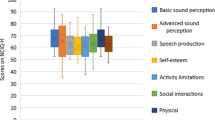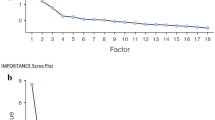Abstract
The NCIQ is a quantifiable self-assessment health-related quality of life instrument specific for cochlear implant users. The aim of this study was to culturally adapt the NCIQ into Italian (I-NCIQ). A prospective instrument validation study was conducted. Cross-cultural adaptation and validation were accomplished. Cronbach α was used to test internal consistency in 51 CI users and in a control group composed by 38 post-lingual deaf adult on a waiting list for a CI. ICC test was used for test–retest reliability analysis. Kruskal–Wallis test with Mann–Whitney post hoc were used to compare the I-NCIQ scores in CI users before and after the cochlear implantation and in control patients. I-NCIQ scores obtained in CI users were compared with the results of Italian version of disyllabic testing without lip-reading and without masking. Good internal consistency and good test–retest reliability were found. I-NCIQ scores obtained in the 51 CI users after implantation were consistently higher than those obtained before implantation and in the control group. Moreover, no differences were found in the results of I-NCIQ obtained in the group of 51 CI users before implantation and in the group of control patients on post hoc Mann–Whitney analysis. Positive correlations between I-NCIQ scores and the results of disyllabic testing without lip-reading and without masking were found. The I-NCIQ is a reliable, valid, self-administered questionnaire for the measurement of QOL in CI users; its application is recommended.
Similar content being viewed by others
References
Blamey P, Arndt P, Bergeron F et al (1996) Factors affecting auditory performance of postlinguistically deaf adults using cochlear implants. Audiol Neurootol 1:293–306
Hinderink JB, Krabbe PFM, Van den Broek P (2000) Development and application of a health-related quality-of-life instrument for adults with cochlear implants: the Nijmegen Cochlear Implant Questionnaire. Otolaryngol Head Neck Surg 123:756–765
Hirschfelder A, Gräbel S, Olze H (2008) The impact of cochlear implantation on quality of life: the role of audiologic performance and variables. Otolaryngol Head Neck Surg 138:357–362
World Health Organization (1971) The economics of health and disease. WHO Chron 25:20–24
Maillet CJ, Tyler RS, Jordan HN (1995) Change in the quality of life of adult cochlear implant patients. Ann Otol Rhinol Laryngol 165:31–48
Wyatt JR, Niparko JK, Rothman ML et al (1995) Cost effectiveness of the multichannel cochlear implant. Am J Otol 16:52–62
Wyatt JR, Niparko JK, Rothman ML (1996) Cost utility of the multi- channel cochlear implant in 258 profoundly deaf individuals. Laryngoscope 106:816–821
Harris JP, Anderson JP, Novak R (1995) An outcomes study of cochlear implants in deaf patients. Audiologic, economic and quality of life changes. Arch Otolaryngol Head Neck Surg 121:398–404
Sanchez-Cuadrado I, Gavilan J, Perez-Mora R, Muñoz E, Lassaletta L (2015) Reliability and validity of the Nijmegen Cochlear Implant Questionnaire in Spanish. Eur Arch Otorhinolaryngol 272:1621–1625
Dong RJ, Liu B, Peng XX, Chen XQ, Gong SS (2010) Analysis of reliability and validity of the Chinese version of Nijmegen Cochlear Implant Questionnaire. Zhonghua Er Bi Yan Hou Tou Jing Wai Ke Za Zhi 45:818–823
Rumeau C, Frère J, Montaut-Verient B, Lion A, Gauchard G, Parietti-Winkler C (2014) Quality of life and audiologic performance through the ability to phone of cochlear implant users. Eur Arch Otorhinolaryngol 20 [Epub ahead of print]
Farinetti A, Roman S, Mancini J, Baumstarck-Barrau K, Meller R, Lavieille JP, Triglia JM (2014) Quality of life in bimodal hearing users (unilateral cochlear implants and contralateral hearing aids). Eur Arch Otorhinolaryngol 6 [Epub ahead of print]
Vermeire K, Van Yper L, De Vel E, Dhooge I (2014) Is cochlear implantation an effective treatment for Menière’s disease? B ENT 10:93–98
Beaton DE, Bombardier C, Guillemin F, Ferraz MB (2000) Guidelines for the process of cross-cultural adaptation of self-report measures. Spine (Phila Pa 1976) 25:3186–3191
Folstein MF, Folstein SE, McHugh PR (1975) Mini-mental state. A practical method for grading the cognitive state of patients for the clinician. J Psychiatr Res 12:189–198
Quaranta A, Arslan E, Babighian G, Filipo R (1996) Impianto cocleare. Protocolli di selezione e valutazione dei soggetti adulti. Acta Phon Lat 18:187–265
Quaranta A, Arslan E, Burdo S, Cuda D, Filipo R, Quaranta N (2009) Documento del gruppo SIO impianti cocleari: linee guida per l’applicazione dell’impianto cocleare e la gestione del centro impianti cocleari. Argomenti di Acta Otorhinolaryngol Ital 3:1–5
Mosnier I, Bebear JP, Marx B, Truy E, Lina-Granade G, Mondain M, Sterkers-Artières F, Bordure P, Robier A, Godey B, Meyer B, Frachet B, Poncet-Wallet C, Bouccara D, Sterkers O (2015) Improvement of cognitive function after cochlear implantation in eldery patients. JAMA Otolaryngol Head Neck Surg 141:442–450
Cohen SM, Labadie RF, Dietrich MS, Haynes DS (2004) Quality of life in hearing impaired adults: the role of cochlear implants and hearing aids. Otolaryngol Head Neck Surg 131:413–422
Francis HW, Chee N, Yeagle J et al (2002) Impact of cochlear implants on the functional health status of older adults. Laryngoscope 112:1482–1488
Kou BS, Shipp DB, Nedzelski JM (1994) Subjective benefits reported by adult Nucleus 22-channel cochlear implant users. J Otolaryngol 23:8–14
Damen GW, Grabel S, Olze H (2008) The impact of cochlear implantation on quality of life: the role of audiologic performance variables. Otolaryngol Head Neck Surg 138:357–362
Author information
Authors and Affiliations
Corresponding author
Ethics declarations
Conflict of interest
The authors declare that they have no conflict of interest.
Rights and permissions
About this article
Cite this article
Ottaviani, F., Iacona, E., Sykopetrites, V. et al. Cross-cultural adaptation and validation of the Nijmegen Cochlear Implant Questionnaire into Italian. Eur Arch Otorhinolaryngol 273, 2001–2007 (2016). https://doi.org/10.1007/s00405-015-3765-8
Received:
Accepted:
Published:
Issue Date:
DOI: https://doi.org/10.1007/s00405-015-3765-8




